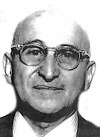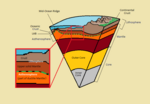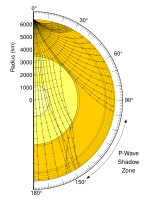 | Beno Gutenberg (/ˈɡuːtənbɜːrɡ/; June 4, 1889 – January 25, 1960) was a German-American seismologist who made several important contributions to the science... 9 KB (880 words) - 08:25, 25 March 2024 |
move deeper and deeper within Earth's core. The Gutenberg discontinuity was named after Beno Gutenberg (1889–1960) a seismologist who made several important... 3 KB (371 words) - 17:23, 15 December 2023 |
Beno Dorn, Polish-English master tailor Beno Eckmann (1917–2008), Swiss mathematician Beno Gutenberg (1889–1960), German-American seismologist Benő Káposzta... 2 KB (235 words) - 08:25, 13 November 2023 |
the Gutenberg–Richter scale, is a measure of the strength of earthquakes, developed by Charles Francis Richter in collaboration with Beno Gutenberg, and... 31 KB (3,381 words) - 16:31, 12 April 2024 |
Gutenberg is a German surname. Notable people with the surname include: Beno Gutenberg (1889–1960), German-born seismologist Erich Gutenberg (1897–1984)... 407 bytes (78 words) - 02:47, 1 June 2022 |
it summarizes a region's seismic activity. The term was coined by Beno Gutenberg and Charles Francis Richter in 1941. Seismicity is studied by geophysicists... 2 KB (236 words) - 15:35, 5 September 2023 |
 | iron core. These were the foundations that one of Wiechert's students, Beno Gutenberg, used to discover the three-layered Earth in 1914. As part of Felix... 7 KB (719 words) - 00:19, 7 March 2024 |
Charles Francis Richter in 1935, with modifications from both Richter and Beno Gutenberg throughout the 1940s and 1950s. It is currently used in People's Republic... 7 KB (921 words) - 08:30, 19 May 2023 |
 | Crackling noise (section Gutenberg–Richter law) crackling noise was done in the late 1940s by Charles Francis Richter and Beno Gutenberg who examined earthquakes analytically. Before the invention of the well-known... 19 KB (2,425 words) - 20:05, 13 August 2023 |
1972) June 2 – Martha Wentworth, American actress (d. 1974) June 4 – Beno Gutenberg, German-American seismologist (d. 1960) June 10 – Sessue Hayakawa, Japanese... 36 KB (4,045 words) - 05:56, 15 April 2024 |
variously denoted as Ms, MS, and Ms, is based on a procedure developed by Beno Gutenberg in 1942 for measuring shallow earthquakes stronger or more distant than... 53 KB (5,868 words) - 04:28, 6 April 2024 |
film actress (b. 1921) Rutland Boughton, English composer (b. 1878) Beno Gutenberg, German-American seismologist (b. 1889) January 27 – Osvaldo Aranha... 89 KB (9,321 words) - 07:58, 7 April 2024 |
meters large) are called "Gutenberg" level, originally from Core–mantle boundary named after German seismologist Beno Gutenberg. The largest klaxosaur class... 45 KB (2,443 words) - 18:46, 8 March 2024 |
a surface-wave magnitude scale (Ms) by Beno Gutenberg in 1945, a body-wave magnitude scale (mB) by Gutenberg and Richter in 1956, and a number of variants... 47 KB (5,924 words) - 13:59, 6 April 2024 |
 | distant events that were used (especially by European scientists like Beno Gutenberg) to study the attributes of the Earth's interior. Seismometers that... 13 KB (1,566 words) - 15:11, 2 March 2024 |
 | In November 1929, Milanković received an invitation from Professor Beno Gutenberg of Darmstadt to collaborate on a ten volume handbook on geophysics and... 64 KB (7,606 words) - 01:30, 19 April 2024 |
Advisory Committee on Antarctic Names after German-born seismologist Beno Gutenberg, director of the California Institute of Technology seismology laboratory... 1 KB (141 words) - 11:13, 27 December 2023 |
Erich Andrée, Gustav Angenheister [de], Immanuel Friedländer [de], Beno Gutenberg, Franz Kossmat, Gerhard Krumbach [de], Karl Mack [de], Ludger Mintrop [de]... 2 KB (213 words) - 12:03, 14 December 2022 |
in United States in 1939 by American seismologists Hugo Benioff and Beno Gutenberg at the California Institute of Technology at Pasadena, based on observations... 28 KB (3,290 words) - 18:58, 28 December 2023 |
 | where Beno Gutenberg was his advisor. Gutenberg was a pupil of the founder of modern seismology Emil Johann Wiechert. Beno and Hertha Gutenberg later... 11 KB (1,128 words) - 22:35, 24 March 2024 |
 | is in a liquid or molten form. The discontinuity was discovered by Beno Gutenberg, a seismologist who made several important contributions to the study... 9 KB (943 words) - 04:28, 7 March 2024 |









